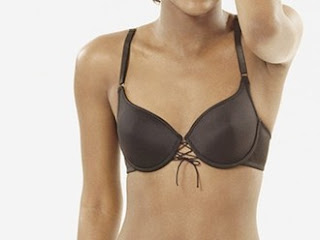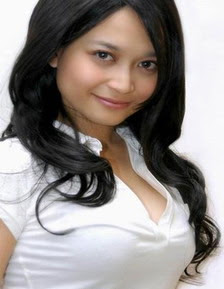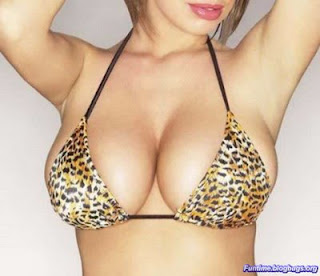Today’s tutorial offers a pulse raising plethora of photo effects
that you can use to pull off poignant presentation that is bound to
leave a breathless impression. To get started all you will need is a
copy of Adobe Photoshop, Illustrator for a few additional effects, and a
pretty photo (ours is from bigstockphoto.com). These effects were used
in the featured photos on all 3 pages of our Trashy Lingerie Template.

You can download the Trashy Lingerie Template,
along with the full PSD source files for this template in BoxedArt’s
members section, as well as thousands of other website templates and web
design products.
Step 1 – Separate the Model from the Background
First, you will need to pick out a lovely image to begin enhancing. Here’s ours:

Now that you have your photo ready to go, open up the image in
Photoshop and start to path out the model from the existing background.
How do you do it? It’s easy, but you’ll need a steady hand and the
ability to avoid distractions to get it path out nicely. Grab your pen
tool and start your path according to the model’s outter most curves.
Try to be as accurate as possible.

Step 2 – Copy the Path You Outlined
After you have finished drawing your path, go to your path window,
and hold on to CTRL and click on the path, it will make a selection of
the model you just pathed out. Then press CTRL-C to copy the model.

Step 3 – Moving the Model to a Neutral Background
Now, open a new document with the size of 570 X 630 and fill it with black as the background.

Next, press CTRL-V to paste the model image to your new document.
Place it at the center of the page, and then select the image and add
feather by going to Select > Modify > Feather and set Feather
Radius to 2 px and press OK. Invert the selection (Select > Invert)
and hit the delete button. You will see your image will have feather
effect around it, which will soften the path lines that you made
earlier.

Step 4 – Masking the Bottom Layer
Next, let’s mask out the bottom of the image so that it blends up
with the background later on. Click on the layer which has your model
image, and click the add mask button below your layer window.

Now grab the gradient tool and apply a gradient from bottom to top and you will have the leg part feathered and blended.

Step 5 – Setting Foreground Color and Effects
Add a new layer below the model layer and grab your gradient tool
again. Set the foreground color to # 35323d and also set the foreground
to Transparent.

Then drag it from right to left and you will get the below results.

Now it looks kind of plain, so let’s add in some effects. Again add
the mask on that layer and grab your brush tool. Open up your brushes
window, and select fire brushes. (You can download these fire brushes
from Deviantart.com)

I used the fire 9 Brush anded mask the background with it. This is the result effect you going to get.

Step 6 – Glowing Circles and Lines
Now let’s move to the glowing circles and lines effect. I’m going to
do this in Adobe Illustrator, so load up your Adobe Illustrator software
and get ready a document. We will start with the first circle, grab the
Ellipse Tool, and draw a large circle;

But before that, set your stroke color to # 666666 and stroke weight
3px. After you have drawn the circle, go to the Transparency tab and set
the Blending mode to Color Dodge, and transparency 29%.

Step 7 – Adding a Second Circle
Once you have done with the first circle, it’s time to add in the
second circle. Using the same tool and same color but this time we need
to use a different stroke weight; set it to 10px.

Draw another big circle, almost the same size, and place it towards the right like the below diagram.

After that, we need to set the Blending mode again to Color Dodge and transparency to 50%.

Step 8 – Circle Duplication
To save up some time and to get a more accurate circle that is the
same size as the previous circle, click on the first circle and hold on
to the ALT key and drag it to the left; you will get another same size
circle.

Now set the stroke weight to 5px, Blending mode to Color Dodge, and transparency to 50%.

Step 9 – Adding in a Glowing Circle
In total, we need 5 circles, so now that we have drawn 3 circles
there are 2 more to go. The 4th circle is harder, as we need to add in
the Gaussian effect, and also the gradient glowing effect. Here’s how to
do it; again select one circle and hold on to the ALT key and drag it
around the center of the artboard.

Set the stroke weight to 10px and go to Object > Expand and press
OK. Your stroke will be expanded and you can change the color now.

Grab the gradient tool, set the gradient slider’s colors as the diagram shows, and pull it across the circle.
From left to right Purple #7d0070, Blue #0954bf, Cyan #00e6db, Pastel Purple #
7051e1, Green #3b8552, Light Blue #85d9ff and Dark Blue #00004f.

As for this circle, we don’t need the Blending mode and transparency so just set it back as default.

Step 10 – The Last Circle
Now, duplicate another circle, and set the color to white with a
weight of 2px, and place it on top of the circle with a gradient color.

Step 11 – Giving the Circles a Soft Glow
It’s time for the final step for the circle effects; the soft glow of
the colored main circle. Select the colored circle, double click on the
scale tool, and press copy. You will get another circle at the same
place. Now, go to Effect > Blur > Gaussian blur, and set the
radius to 10 pixels.

Then, move the glow behind the color circle. Now, select all and press CTRL-C to copy everything, and move back to Photoshop.

Step 12 – Pasting the Results Back into Photoshop
Now, you will be back to your Adobe Photoshop application, press
CTRL-P to paste as vector smart object. Make sure the layer is below the
model image so that it doesn’t cut off the model’s pretty little head.
Place it just like the below diagram.

Step 13 – Stroke and Curl Effects
Let’s add more effects such as stroke and circle effects to the
image. Here, I have prepared some glowing strokes, circles, and lighting
effect. Basically, the glowing effect is the same as the above using
the Gaussian effect.

Step 14 – Stroking The Model’s Chest
Now, grab the Strokes 2 vector, and place it above the model image to
like the below diagram. I Set the Blending mode to Screen, and I masked
out part of it on the chest of the model. I’m sure by now you know how
to use the mask tool.

Step 15 – Stroking Behind the Lingerie Model
Time to add in more strokes, grab Strokes 1 and this time place it
behind the model image just like below. Again, set the blending mode to
screen as well.

Step 16 – Placing Other Effects
Place the dots effect on top of the model image and the circles
behind the image model, but we don’t need to set the blending mode
option this time. You will get the results as below.

Step 17 – Final Brush Effect
Finally, we are almost done; there is just a last brush effect to the
lingerie model image. Grab your brush tool, and use the fire brush
effect again. Before that, add a new layer above the model image layer,
and set your foreground color to orange # ff9f00. Get the fire brush 3
and set the size according to the diagram below.

After that click the brush on the left side of the model and set the
blending mode to overlay. Done! Below is the final result that you can
use in your website designs!

You can download the Trashy Lingerie Template,
along with the full PSD source files for this template in BoxedArt’s
members section, as well as thousands of other website templates and web
design products.



























